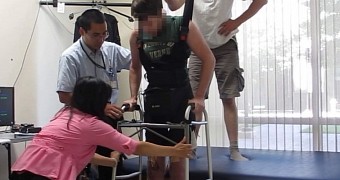The advancement of technology begins to help paraplegics these days more than probably any other human disfunction, and if patients previously needed exoskeletons to be able to walk via wired electrodes, now wireless electrodes may reduce the extra physical interface to the bare minimum.
There's not much a man can do about it when he loses control of its hands and legs after suffering a spinal cord accident, and since ways to treat these issues have been found, most of them are cumbersome and pretty expensive.
Although not many people would put a price on the ability to walk again, those that don't would find that a recent technological development allows patients to control their legs again via wirelessly connected electrodes on the head and legs of the patient that get mitigated by a computer.
Recently, a 26-year-old man that had been in a wheelchair for five years after an accident rendered him paralyzed from the waist down managed to walk again after scientists rerouted signals from his brain to electrodes on his knees. Apparently, he is the first man in history that walks without the aid of robotic limbs or additional exoskeletons.
Would you carry your brain-wave computing system, or would you have it implanted in your brain?
After being fitted with an electrode cap that picks up brain signals, it beams them wirelessly to a computer that deciphers the waves via a complicated algorithm and sees if the intention is to stand still or walk. The signal is then transmitted to a microcontroller on the man's belt that will trigger the muscles that move the legs.
Although the patient needed 20 weeks to properly develop both the muscles and the right brain signals for the computer to interpret properly, the overall experiment worked. The scientists published the findings in the Journal of NeuroEngineering and Rehabilitation, suggesting that a rerouting computer would be needed to actually connect the brain with the muscles via electrodes.
Although a bit Sci-Fi-ish, the medical team believes that the "cumbersome nature of the current noninvasive [computer] system... can potentially be addressed by a fully implantable brain-computer interface system, which can be envisioned to employ invasively recorded neural signals."
This might not be acceptable to some people while the ability to carry your future noninvasive computer system like a smartphone when wishing to take a walk might seem a better solution to most patients.
Nevertheless, this is an incredible discovery, and hopefully it will be successfully used by a much wider number of people.

 14 DAY TRIAL //
14 DAY TRIAL // 